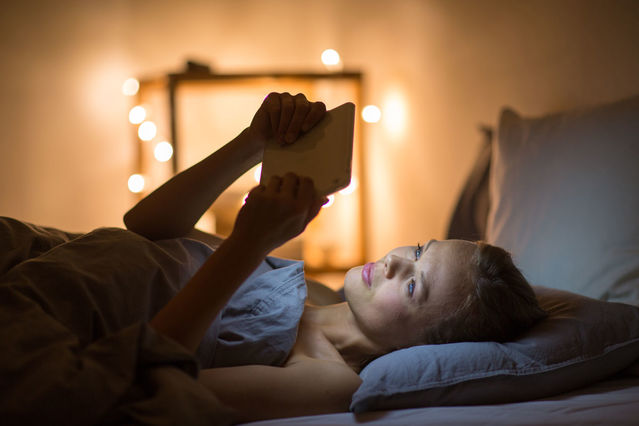Sleep
Protect Yourself From Blue-Light Exposure
The latest on blue light reveals its effect on your health and sleep.
Posted January 6, 2018

When I’m trying to live my best, healthiest life—and most of us are—I pay daily attention to how I’m treating my body. I watch the food I’m eating, and the exercise I’m getting. I pass on that third glass of wine, and set my alarm to make it to spin class a couple of times a week.
But how much thought should we give to light exposure? I tell all my patients: Light is medicine. Just as you wouldn’t expect to eat junk food all day every day and feel healthy and at your best, you can’t consume all kinds of junk light, all the time, and expect to feel, sleep, and perform well. Managed correctly, light exposure can boost performance, improve sleep, and increase energy. In today’s lit-up world, being a savvy, informed consumer of light can help you protect your health and sleep, and allow you to function at your best during the day.
In the modern world, light is everywhere we turn, and we have to actively seek out darkness. There’s also more blue-wavelength light than ever. This short-wavelength light is plentiful in many energy-efficient light sources and digital devices.
Why is blue light significant? Read on to learn about both the hazards and the benefits of blue light.
How nighttime blue light interferes with sleep
I’ve seen an avalanche of evidence in recent years about the potential hazards of blue-wavelength light. (I talked about blue-light exposure, and how to manage it, on CBS This Morning recently.)
Scientific studies have pinpointed blue light as a form of light that’s especially aggressive in triggering sleeplessness. Blue light suppresses melatonin production for more than twice as long as other light wavelengths, and alters circadian rhythms by twice the degree. Interference with the body’s 24-hour circadian rhythms can have a significant effect on health, creating problems with the cardiovascular, metabolic, and immune systems; disturbing mood; and compromising cognitive function. When your circadian rhythms are out of whack, you think, feel, and perform below your best—and over time, your health can be put at risk.
New research adds to this already large body of evidence of the power of blue light to interfere with sleep. The study of healthy young adults found that exposure to blue light from computer screens between the hours of 9 and 11 p.m.:
1. shortened their total sleep time
2. significantly suppressed melatonin production
3. diminished sleep quality, by increasing the frequency of nighttime awakenings
Researchers also found blue light prevented body temperature from dropping during the night. A gradually lowering body temperature is one key element of the body’s progression into sleep. That blue light kept body temperature elevated to daytime levels is a sign of the degree to which nighttime blue-light exposure can disrupt normal circadian rhythms. After nights of blue-light exposure, participants were more tired during the day, and experienced more negative moods.
The study compared the effects of blue light and red light, which has a longer wavelength. Scientists found red-light exposure during the same two-hour evening time period did not interfere with sleep and circadian biology. Body temperature lowered, and sleep progressed as normal.
The takeaway? Nighttime blue-light exposure is indeed harmful to sleep and circadian rhythms. And taking steps to manage blue-light exposure—including using red light sources during evening hours—can make a real difference.
When blue light is beneficial
While a hazard to health and sleep at night, blue-light exposure can be helpful during the day—especially in the morning and early afternoon. Research shows exposure to blue light during daytime hours can be beneficial in several ways, including:
• Reducing daytime sleepiness
• Speeding reaction times
• Elevating alertness
• Strengthening attention span
Research suggests we don’t need prolonged exposure to blue light to achieve its benefits. A study found 30 minutes of blue-light exposure in the morning led to better working memory performance and faster reaction times, compared to other light exposure.
Part of managing light exposure in today’s world is understanding how light can be used to enhance performance and support good health and sleep.
Ways to regulate blue-light exposure
New scientific advancements and technology are helping to provide more ways than ever to tailor, target, and manage light exposure, to reduce health hazards and also to take advantage of the benefits of well-timed light exposure to health and performance.
Carotenoid supplements. Research suggests carotenoid supplements may help strengthen the eye’s natural ability to block blue light. The eye has its own blue-light shield—it’s called the retinal pigment epithelium, a thin layer of cells near the retina. This epithelial layer protects the retina against macular degeneration and acts as a filter for blue-wavelength light. The cells of this layer contain carotenoids, which we absorb through our diet. Research indicates carotenoids are effective at absorbing blue-wavelength light. Carotenoids including lutein and zeaxanthin are available in supplement form and may not only help protect the eye but also may help protect against any unwanted stimulating effects of blue-light exposure.
Blue light–filtering software and apps. There are a number of apps that work to reduce blue-light exposure during evening hours. Many smartphones and tablets include these blue light–filtering apps as part of their operating systems. Apple’s Night Shift is a built-in iOS app, that can be scheduled to shift to warmer, redder wavelength light in the evenings and back to bright, more highly blue-wavelength light in the morning. (Head’s up, iPhone users: The recent software upgrade to iOS 11 has changed the location of the Night Shift app in the phone’s control panel.) Flux is free software that adjusts the light of your computer to match the cycle of natural sunlight where you live and reduces brightness and blue light in the evening.
Blue light–blocking filters and glasses. Both filters for screens and blue light–blocking eyewear are available to reduce unwanted, poorly timed exposure.
Targeted, specialty light bulbs. One of the most effective ways to manage light exposure is to use LED light bulbs that provide the specific kind of light that’s best for day and night. Energy efficient LED light bulbs are now made with our circadian biology in mind. Designed to minimize the negative effects of blue-wavelength light at night, they then take advantage of those stimulating effects during the day. In our household, we use Lighting Science’s Good Night bulbs in the bedrooms and their Good Day bulbs in other places. These daytime bulbs are designed to help stimulate alertness and boost focus. I use them in my office, and they’re great in the family's bathrooms, to give adults—and kids—that performance-boosting dose of light first thing in the morning.
It’s not only technology, but everyday habits that make a difference between light exposure that’s healthful and harmful. Remember to do the following:
Get plenty of light exposure throughout the day. Light exposure during the day boosts attention and alertness, improves mood and cognitive function, strengthens circadian rhythms, and can help you sleep better at night. Spending 10 or 15 minutes in the sunlight during the day—first thing in the morning or on a break at lunch—is a healthful, nourishing light routine.
Keep screens away from your face at night. It’s one thing to relax in front of the television for a while during the evening and quite another to have your head buried in your smartphone right up until lights out. The degree and intensity of artificial and blue-wavelength light exposure matter. As part of your Power Down Hour, give yourself a mobile device cut-off time. That’s when you’ll stow your phone for charging—somewhere other than your bedside table. The closer you get to bedtime, the less interactive your media consumption should be. Studies show that social media and other highly interactive forms of media (think: video games and app games) are especially disruptive to sleep.
Modern light exposure requires modern solutions and strategies. Pay attention to your “light diet” and use the help that’s available to make the light in your life work on behalf of your health and well-being.




